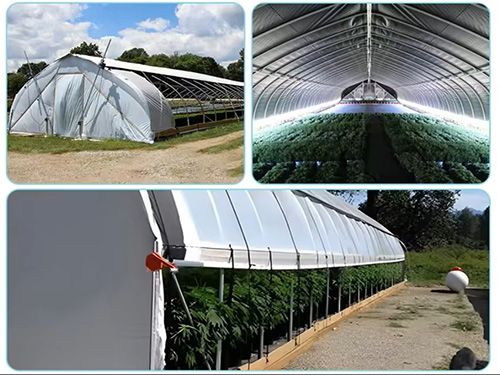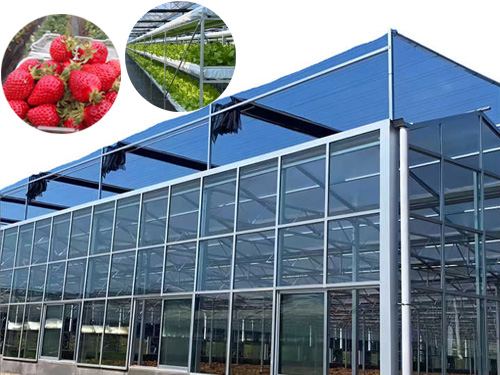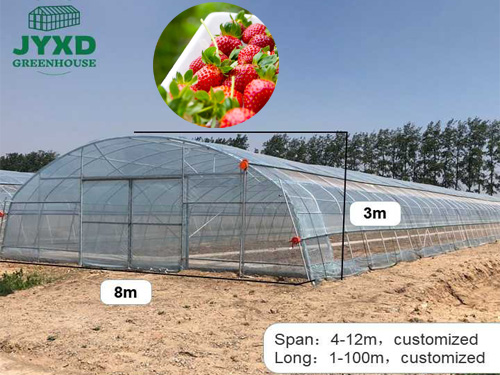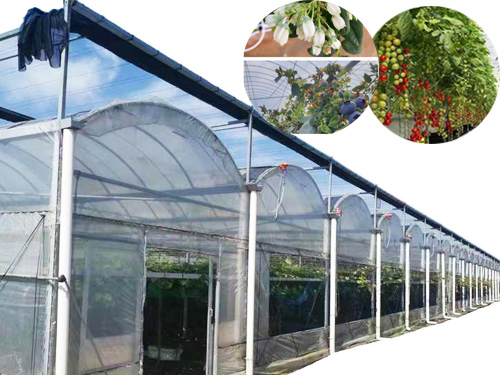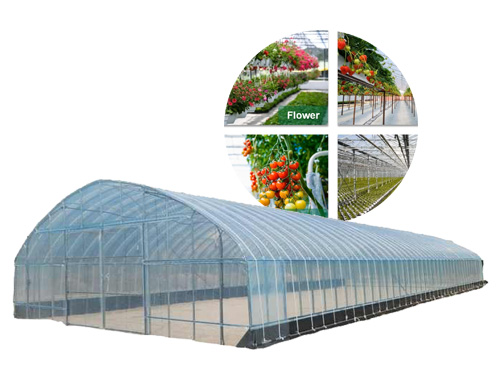NEWS DETAILS
NEWS INFORMATION
Forested Area Greenhouse Challenges: Light Optimization & Wildlife Interaction Management
AUTHOR:jyxd-greenhouse DATE:2025-04-10 17:57:55 HITS:171
Greenhouses in forested areas offer a unique opportunity to blend agriculture with natural ecosystems. However, they also present specific challenges, such as limited sunlight and wildlife interactions, which can impact crop growth and greenhouse operations. By implementing strategies for light optimization and wildlife management, growers can overcome these challenges and create a sustainable and productive greenhouse environment. This article explores effective solutions for maximizing light and managing wildlife in forested area greenhouses.
Why Forested Area Greenhouses Need Special Attention
Forested areas provide a natural buffer and aesthetic appeal, but they also introduce challenges:
· Light Limitation: Dense tree canopies can block sunlight, reducing photosynthesis and crop yields.
· Wildlife Interactions: Animals may damage crops, structures, or equipment.
· Microclimate Variations: Forested areas can have unique temperature and humidity conditions that affect greenhouse climate control.
Addressing these challenges is essential for ensuring the success of forested area greenhouses.
1. Light Optimization Strategies
Maximizing sunlight exposure is critical for healthy plant growth. Here are strategies to optimize light in forested area greenhouses:
Site Selection:
· Openings in the Canopy: Choose locations with natural clearings or gaps in the tree canopy to allow more sunlight.
· Orientation: Position the greenhouse to face the sun’s path, typically south in the Northern Hemisphere and north in the Southern Hemisphere.
Tree Management:
· Selective Pruning: Trim branches to reduce shade while maintaining the forest’s ecological balance.
· Tree Removal: Remove a limited number of trees to create sunlight pathways, ensuring compliance with local regulations.
Supplemental Lighting:
· LED Grow Lights: Use energy-efficient LED lights to provide additional light during periods of low sunlight.
· Light Reflectors: Install reflective materials or mirrors to redirect natural light into the greenhouse.
Greenhouse Design:
· Translucent Materials: Use polycarbonate or glass with high light transmission properties.
· Vertical Farming: Optimize space by growing plants vertically to maximize light exposure.
2. Wildlife Interaction Management
Wildlife can pose challenges to greenhouse operations, but with proper management, these interactions can be minimized. Here’s how:
Physical Barriers:
· Fencing: Install sturdy fences around the greenhouse to keep out larger animals like deer or raccoons.
· Netting: Use bird netting or mesh to protect crops from birds and small mammals.
· Seal Openings: Ensure doors, vents, and windows are securely closed to prevent entry by small animals.
Deterrents:
· Motion-Activated Devices: Use sprinklers, lights, or sound devices to scare away wildlife.
· Natural Repellents: Apply non-toxic repellents like garlic or pepper sprays to deter pests.
Habitat Management:
· Buffer Zones: Create buffer areas with plants that attract wildlife away from the greenhouse.
· Feeding Stations: Set up feeding stations at a distance to divert animals from the greenhouse.
Monitoring and Response:
· Wildlife Cameras: Install cameras to monitor animal activity and identify potential threats.
· Rapid Response Plans: Develop protocols for addressing wildlife intrusions promptly and safely.
3. Benefits of Forested Area Greenhouses
Despite the challenges, forested area greenhouses offer unique advantages:
· Natural Insulation: Trees provide windbreaks and temperature regulation, reducing energy costs.
· Biodiversity Support: Integration with forest ecosystems promotes biodiversity and ecological balance.
· Aesthetic Appeal: Greenhouses in forested areas blend seamlessly with nature, enhancing their visual appeal.
4. Case Studies: Successful Forested Area Greenhouses
Greenhouse in the Pacific Northwest:
· Challenge: Limited sunlight due to dense evergreen forests.
· Solution: Selective tree pruning and LED grow lights increased light levels, boosting crop yields.
Farm in the Amazon Rainforest:
· Challenge: Wildlife damage from monkeys and birds.
· Solution: Bird netting and motion-activated deterrents protected crops without harming wildlife.
Operation in the Black Forest, Germany:
· Challenge: Microclimate variations affecting temperature control.
· Solution: Insulated greenhouse materials and automated climate control systems maintained optimal conditions.
5. Best Practices for Forested Area Greenhouse Management
To maximize the success of your forested area greenhouse, follow these best practices:
Regular Maintenance:
· Inspect Barriers: Check fences, nets, and seals regularly for damage or wear.
· Monitor Lighting: Ensure supplemental lights and reflectors are functioning optimally.
Engage Experts:
· Arborists: Consult tree care professionals for selective pruning or removal.
· Wildlife Biologists: Work with experts to develop wildlife management plans that balance agriculture and conservation.
Invest in Technology:
· Automated Systems: Use sensors and automation for climate control and lighting adjustments.
· Data Analysis: Track environmental data to optimize greenhouse conditions and crop growth.
Promote Sustainability:
· Eco-Friendly Practices: Use renewable energy, organic fertilizers, and non-toxic pest control methods.
· Community Involvement: Educate local communities about the benefits of forested area greenhouses and encourage conservation efforts.
6. Benefits of Light Optimization and Wildlife Management
Implementing these strategies offers numerous advantages:
· Increased Yields: Optimized light levels enhance photosynthesis and crop productivity.
· Crop Protection: Effective wildlife management reduces damage and losses.
· Sustainability: Balancing agriculture with forest ecosystems promotes environmental health.
· Cost Efficiency: Reduced energy use and crop losses lower operational costs.
Conclusion
Forested area greenhouses present unique challenges, but with effective light optimization and wildlife interaction management, growers can create a sustainable and productive environment. By maximizing sunlight, protecting crops from wildlife, and leveraging technology, you can overcome these challenges and achieve successful cultivation. Whether you’re a small-scale farmer or a commercial operator, these strategies will help you make the most of your forested location.
For more expert tips and high-quality greenhouse solutions, visit our website and take your farming practices to the next level. Let’s grow smarter and cultivate a greener future together!
![]()
Meta Description: Discover how to optimize light and manage wildlife interactions in forested area greenhouses. Learn strategies for sustainable and productive cultivation.
Hebei Juyou Xinda Greenhouse Facilities Co.,Ltd.
Copyright © 2024-2025 https://www.jyxd-greenhouse.com. All Rights Reserved Hebei Juyou Xinda Greenhouse Facilities Co.,Ltd.Copyright





 Current Location:
Current Location:


